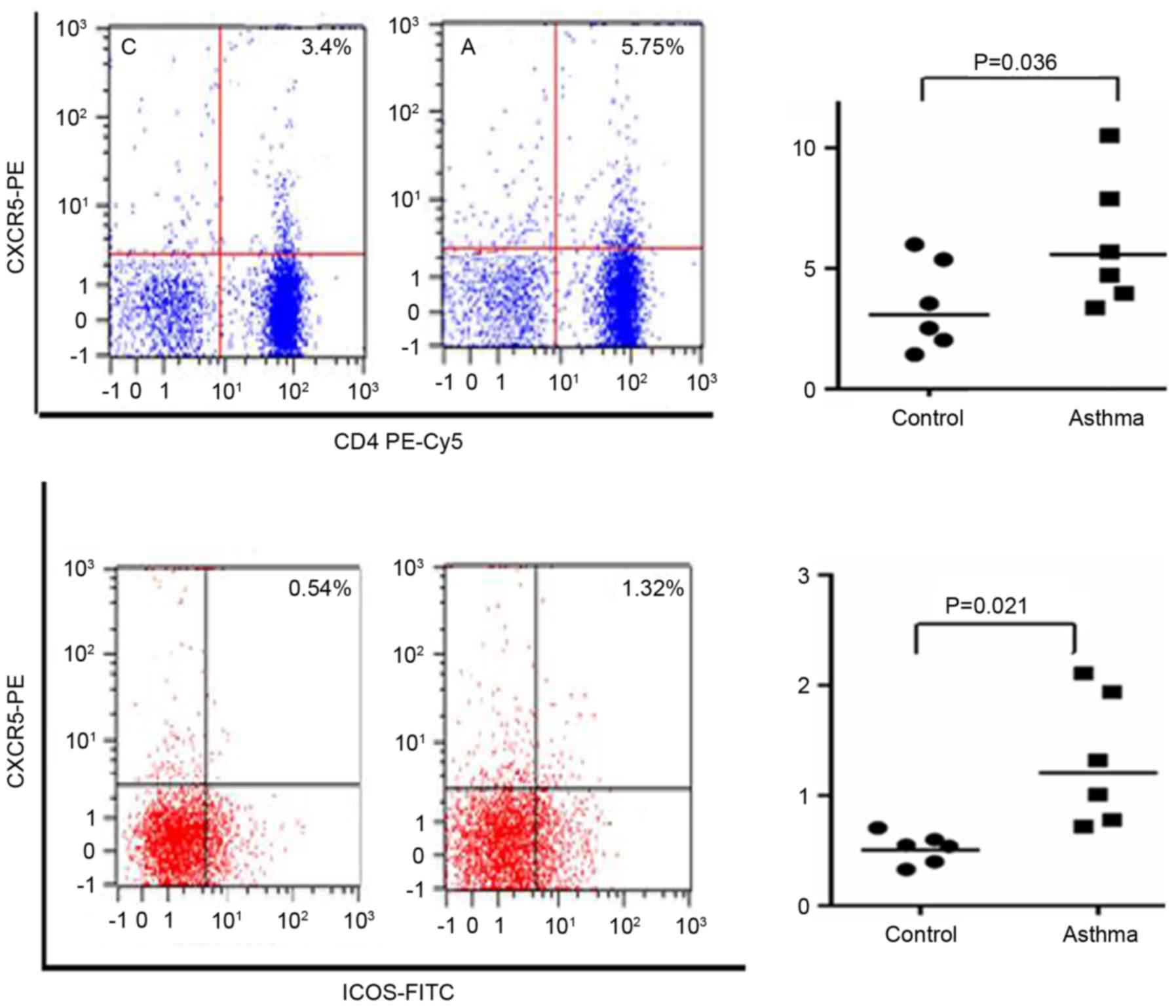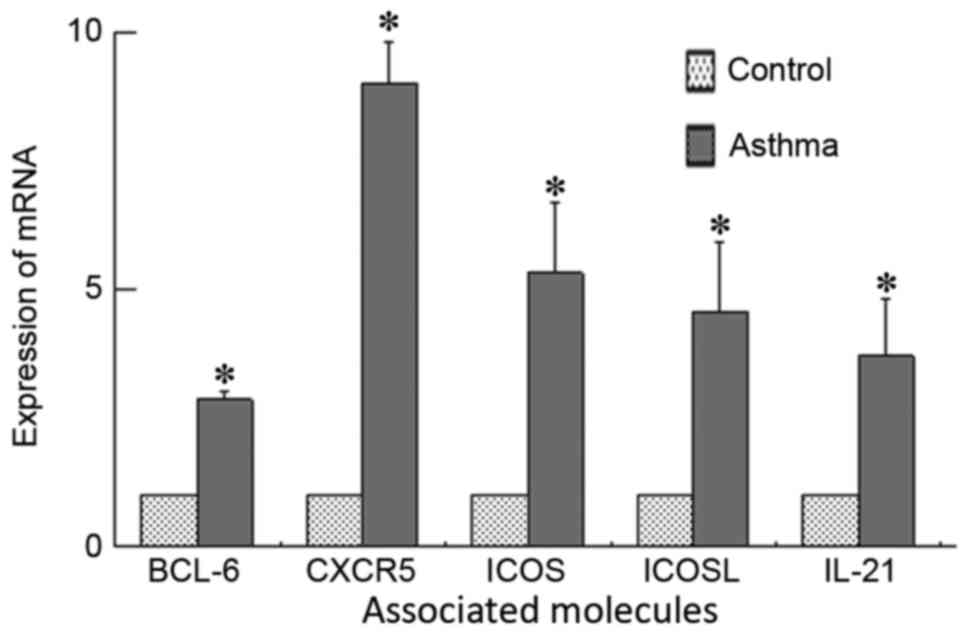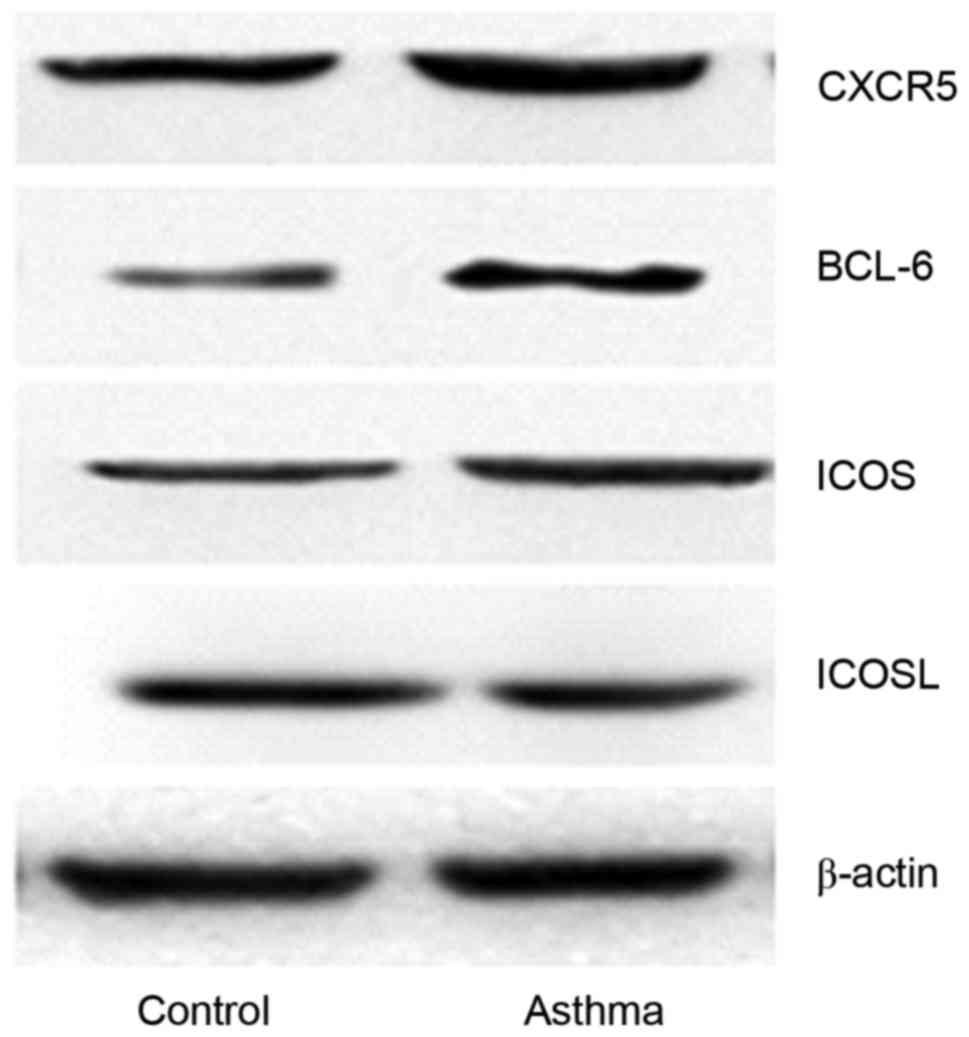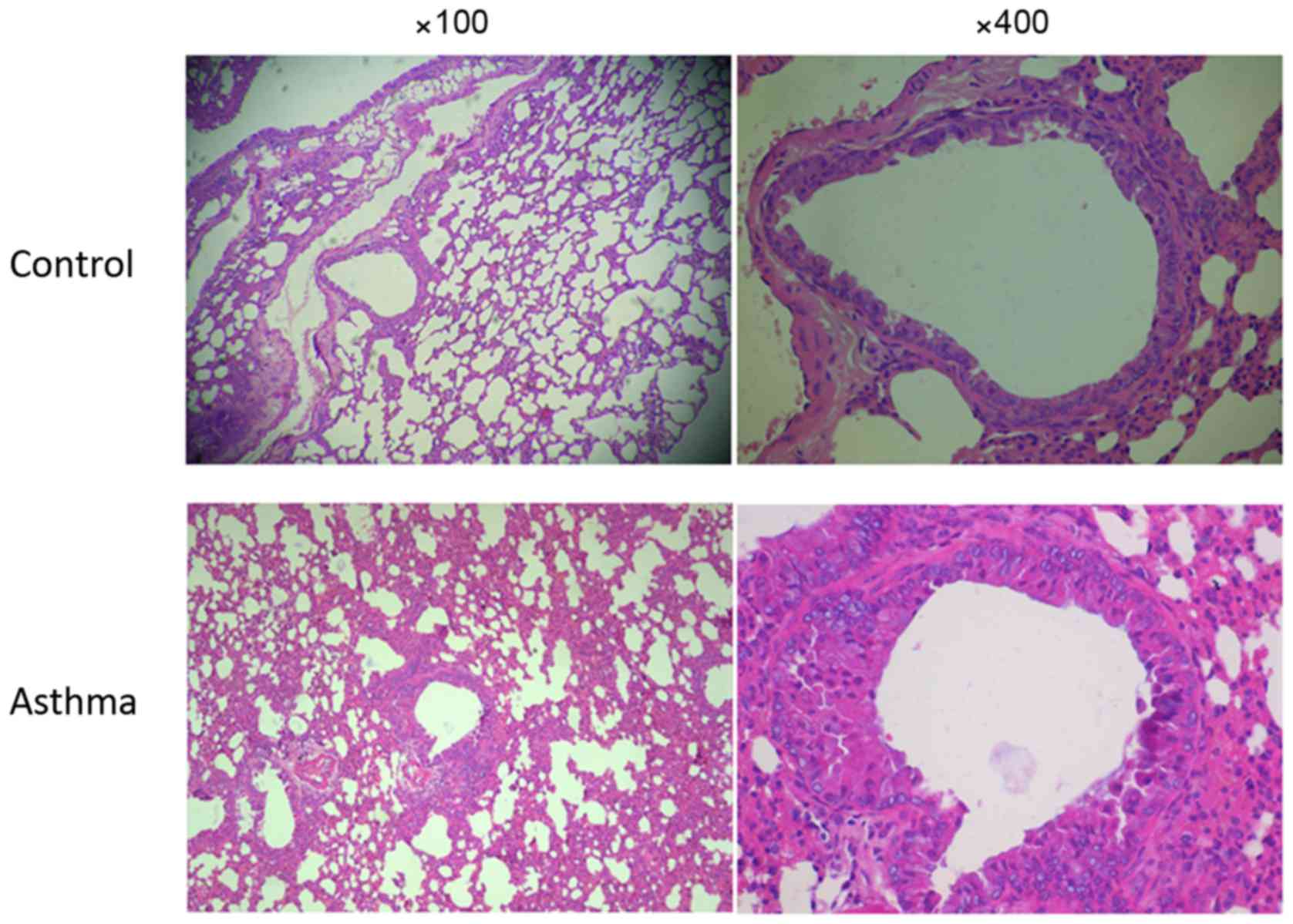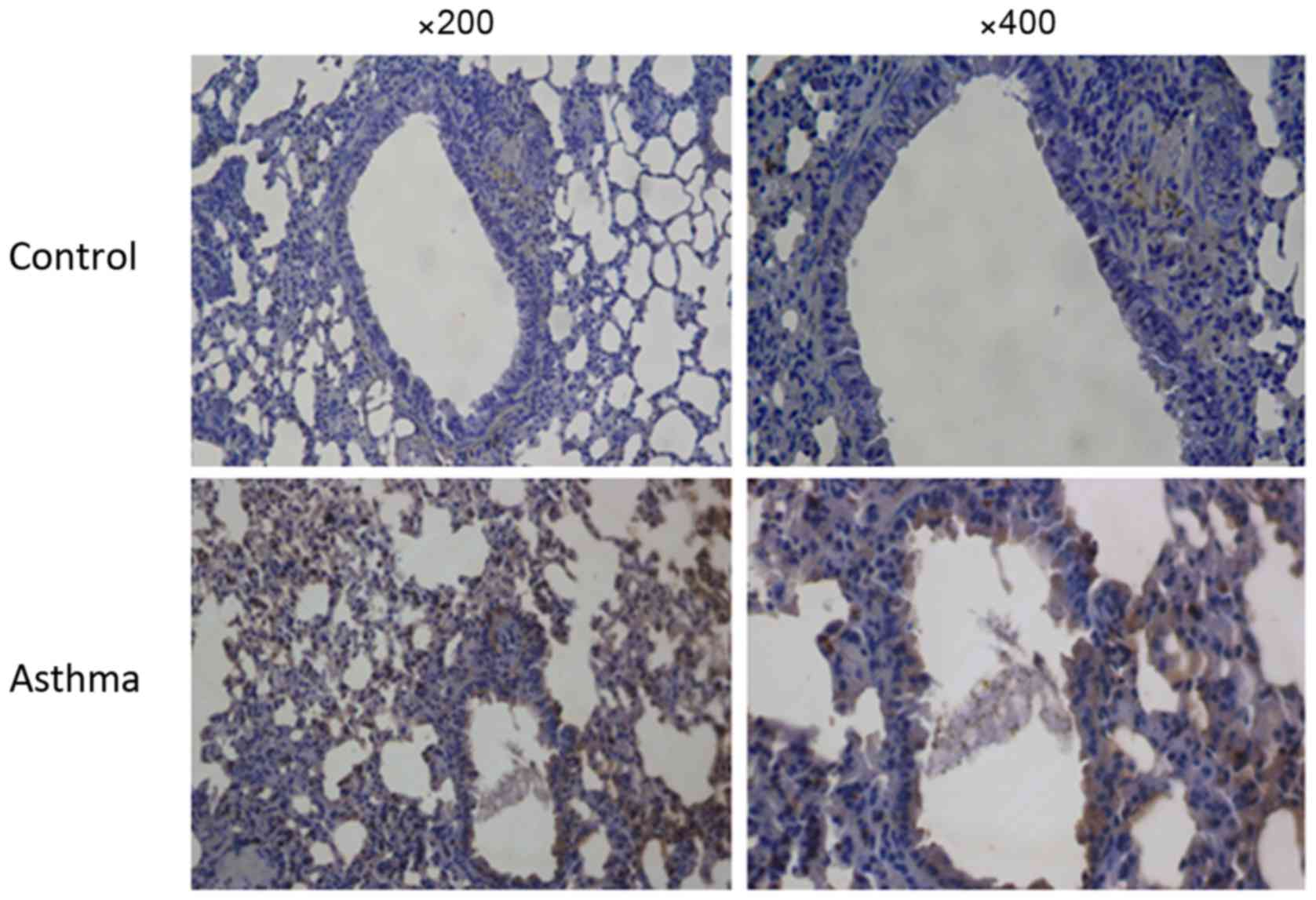Effect of follicular helper T cells on the pathogenesis of asthma
- Authors:
- Published online on: June 16, 2017 https://doi.org/10.3892/etm.2017.4627
- Pages: 967-972
-
Copyright: © Ma et al. This is an open access article distributed under the terms of Creative Commons Attribution License.
Abstract
Introduction
Bronchial asthma is a chronic inflammatory airway disease in which a variety of cells and cytokines are involved, including eosinophils, macrophages, neutrophils and Th2 cells, in addition to other inflammatory cytokines and chemokines (1–3). Although the mechanism of asthma remains unclear, previous studies have suggested that an imbalance of Th1/Th2 is directly involved in the inflammatory response of asthma (4,5). The treatment approaches for asthma that are used clinically include hormones, β2 receptor agonists and leukotriene receptor antagonists. However, due to the complex causes and mechanisms of bronchial asthma, these treatments are not satisfactory, and do not significantly reduce the symptoms, which include wheezing, shortness of breath, chest tightness and coughing. Studies have also identified imbalances in Th1/Th2 and Th17/Treg in patients with allergic asthma (6,7). Previous evidence (8) has suggested that follicular helper T (TFH) cells are a specific cluster of differentiation CD4+ effector T cells subset, that is distinguished from T helper 1 (Th1) cells and Th2 cells in the tonsils, spleen and lymph nodes. They specifically maintain the structure and function of germinal centers (GC) and regulate memory B cell responses (9,10). There is also evidence indicating that a TFH imbalance or dysfunction is associated with autoimmune diseases, including systemic lupus erythematosus, rheumatoid arthritis and autoimmune thyroiditis (11–13). To the best of our knowledge, the functions of TFH cells in the pathogenesis of asthma, however, have not been reported. The present study hypothesized that TFH cells affect the asthma pathogenesis via TFH-associated markers.
Materials and methods
Animals
A total of 16 female BALB/c mice (6–8 weeks old, 20–22 g), purchased from the Animal Experiment Center, Xinjiang Medical University (Xinjiang, China), were housed in microisolator cages and received a regular diet (access to food and water ad libitum). The laboratory temperature was 24±1°C, and the relative humidity was 40–80%. All experimental protocols were approved by the Animal Ethics Committee of the First Affiliated Hospital of Xinjiang Medical University.
Reagents
Ovalbumin (OVA) was used as an allergen (Sigma-Aldrich; Merck KGaA, Darmstadt, Germany). Aluminum hydroxide gel was used as an adjuvant (Tianjin Pharmaceutical Group Co., Ltd., Tianjin, China). Anti-mouse inducible T-cell costimulator (ICOS)-fluorescein isothiocyanate (FITC) (11–9942), anti-mouse C-X-C chemokine receptor type 5 (CXCR5)-phycoerythrin (PE) (85–12-1859-41), anti-mouse CD4-PE Cy5 (15-0042-82), anti-mouse CD3-PE-allophycocyanin (APC) (85-17-0032-80) antibodies were purchased from eBioscience (Thermo Fisher Scientific, Inc., Waltham, MA, USA). Red Blood Cell Lysis Buffer was purchased from Tiandz, Inc. (Beijing, China). Lymphocyte separation medium was purchased from Westang Bio-Tech, Co., Ltd. (Shanghai, China). TRIzol, synthesize first-strand cDNA with reverse transcriptase and Platinum SYBR-Green qPCR SuperMix-UDG were purchased from Invitrogen (Thermo Fisher Scientific, Inc.). Primers were designed and synthetized by the Jiancheng Bioengineering Institute of Nanjing (Nanjing, China). SDS-PAGE electrode buffer was purchased from BestBio (Shanghai, China), antibodies against B cell lymphoma 6 (BCL-6) (sc-365618), CXCR5 (sc-8178) and ICOS (sc-65285) were purchased from Santa Cruz Biotechnology, Inc. (Dallas, TX, USA). ICOS ligand (ICOSL) antibody (bs-2471R) and interleukin (IL)-21 rabbit polyclonal antibody (bs-2621R) were purchased from Bioss (Woburn, MA, USA). All other chemicals were of reagent grade.
Model
A total of 16 female BALB/c mice were randomly divided into two equal groups: Control and asthma group (n=8). As previously described (14), mice in the asthma group received an intraperitoneal injection of sensitizing agent 0.2 ml (containing 100 µg OVA and 1 mg aluminum hydroxide gel) on days 1 and 15. The asthma group breathed in 1% OVA for 30 min, starting on day 22, three times per week for 8 weeks. The control group was treated with phosphate-buffered saline (PBS) instead of OVA. Mice were sacrificed by cervical dislocation following the last challenge, and blood, lung and spleen specimens were collected.
Determination of flow cytometry
During the last 2 h of the final challenge, a blood sample was collected from all mice. The spleen was removed following sacrifice and 4 ml red blood cell lysis buffer was added prior to the tissues being ground. The mixtures were filtered and collected by a 75-µm sieve. Red blood cell lysis buffer was added, centrifuged (2,120 × g, 5 min, room temperature) and the supernatant was decanted. Subsequently, 10% RPMI-1640 (1 ml) (Thermo Fisher Scientific Inc.) was added and mixed with lymphocyte separation medium. The lymphocyte layer was aspirated, diluted to 10 ml by PBS and washed it to form a cell suspension. The cell concentration was adjusted with PBS to 1–5×106 cells/ml. Samples were then stained with 0.5 µl antibodies: Anti-mouse ICOS-FITC (1:200), anti-mouse CXCR5-PE (1:200), anti-mouse CD4-PE Cy5 (1:200) and anti-mouse CD3 PE APC (1:100) (away from light at 4°C, 20 min). Cell pellets were resuspended in 500 µl FACS-PBS and maintained on ice prior to flow cytometry analysis. Flow cytometry was conducted on a BD FACSCalibur flow cytometer and analyzed using Cell Quest Pro software version 5.1 (both from BD Biosciences, Franklin Lakes, NJ, USA).
Reverse transcription-quantitative polymerase chain reaction (RT-qPCR)
RNA (2 µl) was extracted from lung tissue, collected following sacrifice, using TRIzol reagent RNA isolation reagent. cDNA was synthesized from 1 µl RNA of each sample using a synthesize M-MLV first-strand reverse transcription system kit (C28025-032) according to the manufacturer's protocol. Primers were designed as follows: 5′-GGAAACCCAGTCAGAGTATTCG-3′ (forward) and 5′-CACATTTGTAGGGCTTTTCTCC-3′ (reverse) for BCL-6; 5′-TCTGCCGTGTCTTTGTCTTCT-3′ (forward) and 5′-GAGCATTGGATTCTTGATGGA-3′ (reverse) for ICOS; 5′-ATCTCGTGGGGATGTTCTGT-3′ (forward) and 5′-GGTTTCCTGTGGGTTCTTTGT-3′ (reverse) for ICOSL; 5′-GACTCCTCTCCATCCACATCA-3′ (forward) and 5′-TAACACCATCCCATCACAAGC-3′ (reverse) for CXCR5; 5′-GGACCCTTGTCTGTCTGGTAG-3′ (forward) and 5′-TGTGGAGCTGATAGAAGTTCAGG-3′ (reverse) for IL-21; and 5′-TGTTACCAACTGGGACGACA-3′ (forward) and 5′-GGGGTGTTGAAGGTCTCAAA-3′ (reverse) for β-actin. RT-qPCR was performed in a 20-µl final volume containing 0.8 µl cDNA sample, 0.4 µl primer pairs and 10 µl SYBR-Green PCR Master mix. PCR was performed as follows: Initial denaturation at 95°C for 2 min, followed by 40 cycles of annealing at the following temperatures: 53.5°C (ICOS), 55°C (CXCR5), 55.1°C (ICOSL), 57.6°C (BCL-6), 56°C (IL-21) and 50°C (β-actin) in an ABI PRISM 7000 (Applied Biosystems; Thermo Fisher Scientific, Inc.) system sequence detector. Each RNA sample was measured in triplicate. The specificity of amplified PCR products was evaluated by a comparative Cq method (15). The threshold cycle value (Cq value) was calculated from cycle number at which the PCR product crosses a threshold of detection. BCL-6, CXCR5, ICOS, ICOSL, IL-21 mRNA expression levels were normalized against β-actin, as determined by the 2−∆∆Cq method.
Western blot analysis
The lungs were removed following sacrifice. Tissue protein (200 µg) was extracted using RIPA lysis buffer (Beijing Solarbio Science and Technology Co., Ltd., Beijing, China) and the concentrations were determined using the bicinchoninic acid method. Proteins (50 µg/well) were separated by 5% SDS-PAGE and transferred onto a polyvinylidene fluoride membrane. Blocking by 5% skim milk powder (65°C, 1 h) was performed following denaturation. Subsequently, the membrane was incubated with primary antibodies (BCL-6 1:500, ICOS 1:1,000, CXCR5 1:2,000, ICOSL 1:300; 4°C, overnight) and secondary antibodies (Goat anti-rabbit IgG 1:10,000; room temperature, 1 h), then developed with the Enhanced Chemiluminescence Plus Western Blotting Detection system (Amersham, Cambridge, UK), according to the manufacturer's instructions.
Hematoxylin-eosin staining
The left lung of each mouse was fixed in 10% formalin for 24 h and embedded in paraffin. Sections of 4–5 µm were cut, deparaffinized, rehydrated and stained with hematoxylin and eosin. A pathologist blind to experimental groups evaluated the changes of lung tissue by using a light microscope.
Immunohistochemistry stain
The left lung tissue was fixed in 10% buffered formalin for 48 h. Tissue samples, from paraffin-wax-embedded blocks, were sectioned to be 4–5 µm thick. Following the process of dewaxing, hydration, closed endogenous peroxidase and antigen repair, polyclonal IL-21 antibody (rabbit anti-mouse, 1:300) and universal secondary antibody (PV6000, ZSGB-BIO, Beijing, China) were applied (1–2 h at room temperature). Slides were observed using a light microscope at a magnification of ×200 and ×400. Sections were considered positive according to the color observation, which is an indication of the antibody-antigen reaction, and manifested as an intracytoplasm brown coloration in different areas of the stained tissue section.
Statistical analysis
SPSS version 17.0 (SPSS, Inc., Chicago, IL, USA) was used to analyse data. Data were presented as the mean ± standard error of the mean. Comparison between groups was made with analysis of variance followed by Dunnett's test. P<0.05 was considered to indicate a statistically significant difference.
Results
Behavioral changes
Mice in the asthma group exhibited symptoms following the challenge with OVA, including anxiety, frequent nose scratching, cough, nodding breathing, shortness of breath, retardation, piloerection and cyanosis. These behavioural activities were decreased following continuous challenge.
Results of flow cytometry
CXCR5 has been identified as an important transport molecule in the process of migration and positioning of TFH cells (16). While ICOS has a role in the differentiation and maturation of TFH cells. As presented in Fig. 1, the ratio of CD4+CXCR5+/CD4+ and CD4+CXCR5+ICOS+/CD4+CXCR5+ in the spleen tissues was significantly increased in the asthma group compared with the control group (P<0.05).
Results of RT-qPCR
Expression levels of BCL-6, ICOS, ICOSL, CXCR5 and IL-21 mRNA in lung tissue are presented in Fig. 2. A significant increase of BCL-6, ICOS, ICOSL, CXCR5 and IL-21 mRNA expression was detected in lung tissue from the asthma group compared with the control group (P<0.05).
Results of western blot analysis
Proteins within the lung tissues of mice were extracted and assayed by western blot analysis. As presented in Fig. 3, the results indicate that BCL-6, CXCR5, ICOS and ICOSL exhibited positive expression. At the same time, the amount of protein was increased in the asthma group compared with the control group.
Changes to lung histopathology
As presented in Fig. 4, alveolar samples from mice in the control group exhibited a normal structure with no histopathological changes observed under the microscope (Fig. 4). However, lung tissue obtained from mice in the asthma group exhibited a marked bronchial epithelial necrosis, thickening of the bronchial walls and smooth muscle hyperplasia, bronchial lumen irregular and mucus plug within it.
Results of immunohistochemistry staining
Positive expression of IL-21 in the cytoplasm of false stratified columnar ciliated epithelium cells is demonstrated in Fig. 5. It was observed that there were more positive IL-21 cells in the asthma group, compared with the control group.
Discussion
Asthma is a type I allergic reaction mediated by immunoglobulin E. CD4+T helper cell (Th), serve a key role in the pathogenesis of allergic inflammation (2). It has previously been suggested that Th1 and Th2 are involved in the inflammatory response of asthma directly (3). However, studies by Afshar et al (17) and others (10–20) have further revealed that Tregs and Th17 cells are also changed in the pathogenesis of asthma. A previous study identified novel subsets of CD4+T cells, named TFH cells, and these were demonstrated to help B cells produce antibodies (8–10). It was identified that certain patients who present with autoimmune diseases including systemic lupus erythematosus, rheumatoid arthritis, autoimmune thyroid disease and immune-active chronic hepatitis B, demonstrate an association between an increased in TFH cells and injury severity of autoantibody and target organs (21,22).
A variety of molecular markers are involved in the differentiation of TFH cells, including CXCR5, ICOS, ICOSL, BCL-6 and IL-21 (23). TFH cells and mature B cells are able to express CXCR5 continuously and stably (24). CXCR5 is a specific receptor of CXCR13, which is a follicular homing chemokine that induces TFH cell migration from the T zone in peripheral lymphoid organs to the center of lymphoid follicles (25). Finally, TFH cells localize to and interact with B cells. Therefore, CXCR5 is known as an important transport molecule in the process of migration and positioning of TFH cells (26). The results of the present study indicate that the mRNA and protein expression levels of CXCR5 were increased in the asthma group, as compared with the control group.
ICOS, as an induced coordinated stimulus molecule, induces the process of TH cell activation and differentiation (23). A previous study indicated that ICOS interacts with ICOSL to deliver coordination and stimulate positive signals (27). It has an important role not only for the generation and survival of TFH cells but also for the formation of GC and memory B cells (28). Choi et al (29) revealed that ICOS provides a critical early signal to induce differentiation and maturation of TFH cells. The present study also revealed that the expression levels of ICOS and ICOSL mRNA and protein were increased in the bronchial asthma group, as compared with the control group.
Flow cytometric analysis demonstrated that, compared with the control group, the ratio of CD4+CXCR5+/CD4+ and CD4+CXCR5+ICOS+/CD4+CXCR5+ in the spleen was higher in the asthma group. These results suggest that the increasing ratio of TFH cell subsets may be an important determinant in the pathogenesis of asthma.
Zinc finger protein, BCL-6, is a transcription receptor that was initially determined to act on B cells (30). Its expression has an important role in the formation of GC. Expression of BCL-6 was indicated at the beginning of TFH cell proliferation and the activation of T cells (28,31). The present study revealed that the expression of BCL-6 at a molecular and protein level in the asthma group was higher than in the control group. The current study demonstrated that an abundance of TFH cells proliferated in the process of asthma pathogenesis.
IL-21 is primarily released from TFH cells in the body. IL-21 combines with its corresponding receptor on the surface of TFH or B cells, thus the expression of IL-21 increases by autocrine function. IL-21 is involved in TFH cell proliferation, development and effectiveness (32). The present study revealed that the expression of IL-21, at the mRNA and protein level, was increased in asthmatic lung tissue.
In conclusion, the results of the current study demonstrated that TFH cells and associated markers have a role in the pathogenesis of asthma. These results suggest that regulation of the abnormal TFH cells in vivo may be a novel strategy for treating asthma, in the future.
Acknowledgements
The present study was funded by Funds for National Science Foundation of Autonomous Region of Xinjiang (grant no. 2015211C012). The authors would like to thank Dr Yuyuan Guo (Xinjiang Medical University) and Mr. Umer Farooq Dost (Xinjiang Medical University) for improving the essay.
References
|
Lemanske RF Jr and Busse WW: Asthma: Clinical expression and molecular mechanisms. J Allergy Clin Immunol. 125 2 Suppl 2:1–102. 2010. View Article : Google Scholar | |
|
Herrick CA and Bottomly K: To respond or not to respond: T cells in allergic asthma. Nat Rev Immunol. 3:405–412. 2003. View Article : Google Scholar : PubMed/NCBI | |
|
Wei M, Chu X, Guan M, Yang X, Xie X, Liu F, Chen C and Deng X: Protocatechuic acid suppresses ovalbumin-induced airway inflammation in a mouse allergic asthma model. Int Immunopharmacol. 15:780–788. 2013. View Article : Google Scholar : PubMed/NCBI | |
|
Balaha MF, Tanaka H, Yamashita H, Rahman MN Abdel and Inagaki N: Oral Nigella sativa oil ameliorates ovalbumin-induced bronchial asthma in mice. Int Immunopharmacol. 14:224–231. 2012. View Article : Google Scholar : PubMed/NCBI | |
|
Park HJ, Lee CM, Jung ID, Lee JS, Jeong YI, Chang JH, Chun SH, Kim MJ, Choi IW, Ahn SC, et al: Quercetin regulates Th1/Th2 balance in a murine model of asthma. Int Immunopharmacol. 9:261–267. 2009. View Article : Google Scholar : PubMed/NCBI | |
|
Shi YH, Shi GC, Wan HY, Jiang LH, Ai XY, Zhu HX, Tang W, Ma JY, Jin XY and Zhang BY: Coexistence of Th1/Th2 and Th17/Treg imbalances in patients with allergic asthma. Chin Med J (Engl). 124:1951–1956. 2011.PubMed/NCBI | |
|
Zhao Y, Yang J and Gao YD: Altered expressions of helper T cell (Th)1, Th2, and Th17 cytokines in CD8(+) and γδ T cells in patients with allergic asthma. J Asthma. 48:429–436. 2011. View Article : Google Scholar : PubMed/NCBI | |
|
Choi YS, Yang JA and Crotty S: Dynamic regulation of Bcl6 in follicular helper CD4 T (TFH) cells. Curr Opin Immunol. 25:366–372. 2013. View Article : Google Scholar : PubMed/NCBI | |
|
Linterman MA and Vinuesa CG: T follicular helper cells during immunity and tolerance. Prog Mol Biol Transl Sci. 92:207–248. 2010. View Article : Google Scholar : PubMed/NCBI | |
|
King C: A fine romance: T follicularhelpercells and B cells. Immunity. 34:827–829. 2011. View Article : Google Scholar : PubMed/NCBI | |
|
Dong W, Zhu P, Wang Y and Wang Z: Follicular helper T cells in systemic lupus eiythematosus: A potential therapeutic target. Autoimmun Rev. 10:299–304. 2011. View Article : Google Scholar : PubMed/NCBI | |
|
Ma J, Zhu C, Ma B, Tian J, Baidoo SE, Mao C, Wu W, Chen J, Tong J, Yang M, et al: Increased frequency of circulating follicular helper T cells in patients with rheumatoid arthritis. J Immunol Res. 2012:8274802012. | |
|
Zhu C, Ma J, Liu Y, Tong J, Tian J, Chen J, Tang X, Xu H, Lu L and Wang S: Increased frequency of follicular helper T cells in patients with autoimmune thyroid disease. J Clin Endocrinol Metab. 927:943–950. 2012. View Article : Google Scholar | |
|
Du Q, Zhang Q, Shen L, Cai JK, Huang M and Yin KS: Effects of Astragaloside IV on airway remodeling in a murine model of chronic asthma. Chin Pharmacol Bulletin. 1–1434. 2011. | |
|
Livak KJ and Schmittgen TD: Analysis of relative gene expression data using real-time quantitative PCR and the 2(−Delta Delta C(T)) Method. Methods. 25:402–408. 2001. View Article : Google Scholar : PubMed/NCBI | |
|
Fazilleau N, Mark L, McHeyzer-Williams LJ and McHeyzer-Williams MG: Follicular helper T cells: Lineage and location. Immunity. 30:324–335. 2009. View Article : Google Scholar : PubMed/NCBI | |
|
Afshar R, Strassner JP, Seung E, Causton B, Cho JL, Harris RS, Hamilos DL, Medoff BD and Luster AD: Compartmentalized chemokine-dependent regulatory T-cell inhibition of allergic pulmonary inflammation. J Allergy Clin Immunol. 131:1644–1652. 2013. View Article : Google Scholar : PubMed/NCBI | |
|
Maazi H, Shirinbak S, Willart M, Hammad HM, Cabanski M, Boon L, Ganesh V, Baru AM, Hansen G, Lambrecht BN, et al: Contribution of regulatory T cells to alleviation of experimental allergic asthma after specific immunotherapy. Clin Exp Allergy. 42:1519–1528. 2012. View Article : Google Scholar : PubMed/NCBI | |
|
Ma C, Ma Z, Fu Q and Ma S: Curcumin attenuates allergic airway inflammation by regulation of CD4+CD25+ regulatory T cells (Tregs)/Th17 balance in ovalbumin-sensitized mice. Fitoterapia. 87:57–64. 2013. View Article : Google Scholar : PubMed/NCBI | |
|
Song L, Guo Y, Deng Q and Li J: TH17 functional study in severe asthma using agent based model. J Theor Biol. 309:29–33. 2012. View Article : Google Scholar : PubMed/NCBI | |
|
Zhang X, Ing S, Fraser A, Chen M, Khan O, Zakem J, Davis W and Quinet R: Follicular helper T cells: New insights into mechanisms of autoimmune diseases. Ochsner J. 13:131–139. 2013.PubMed/NCBI | |
|
Feng J, Lu L, Hua C, Qin L, Zhao P, Wang J, Wang Y, Li W, Shi X and Jiang Y: High frequency of CD4+ CXCR5+ TFH cells in patients with immune-active chronic hepatitis B. PLoS One. 6:e216982011. View Article : Google Scholar : PubMed/NCBI | |
|
Nurieva RI and Chung Y: Understanding the development and function of T follicular helper cells. Cell Mol Immunol. 7:190–197. 2010. View Article : Google Scholar : PubMed/NCBI | |
|
Yu D, Batten M, Mackay CR and King C: Lineage specification and heterogeneity of T follicular helper cells. Curr Opin Immunol. 21:619–625. 2009. View Article : Google Scholar : PubMed/NCBI | |
|
Liu X, Nurieva RI and Dong C: Transcriptional regulation of follicular T-helper (TFH) cells. Immunol Rev. 252:139–145. 2013. View Article : Google Scholar : PubMed/NCBI | |
|
Crotty S: Follicular helper CD4 T cells (TFH). Annu Rev Immunol. 29:621–663. 2011. View Article : Google Scholar : PubMed/NCBI | |
|
Kuo TC, Shaffer AL, Haddad J Jr, Choi YS, Staudt LM and Calame K: Repression of BCL-6 is required for the formation of human memory B cells in vitro. J Exp Med. 204:819–830. 2007. View Article : Google Scholar : PubMed/NCBI | |
|
Simpson TR, Quezada SA and Allison JP: Regulation of CD4 T cell activation and effector function by inducible costimulator (ICOS). Curr Opin Immunol. 22:326–332. 2010. View Article : Google Scholar : PubMed/NCBI | |
|
Choi YS, Kageyama R, Eto D, Escobar TC, Johnston RJ, Monticelli L, Lao C and Crotty S: ICOS receptor instructs T follicular helper cell versus effector cell differentiation via induction of the transcriptional repressor Bcl6. Immunity. 34:932–946. 2011. View Article : Google Scholar : PubMed/NCBI | |
|
Liu R, Wu Q, Su D, Che N, Chen H, Geng L, Chen J, Chen W, Li X and Sun L: A regulatory effect of IL-21 on T follicular helper-like cell and B cell in rheumatoid arthritis. Arthritis Res Ther. 14:R2552012. View Article : Google Scholar : PubMed/NCBI | |
|
Linterman MA, Beaton L, Yu D, Ramiscal RR, Srivastava M, Hogan JJ, Verma NK, Smyth MJ, Rigby RJ and Vinuesa CG: IL-21 acts directly on B cells to regulate Bcl-6 expression and germinal center responses. J Exp Med. 207:353–363. 2010. View Article : Google Scholar : PubMed/NCBI | |
|
Tiriveedhi V, Fleming TP, Goedegebuure PS, Naughton M, Ma C, Lockhart C, Gao F, Gillanders WE and Mohanakumar T: Mammaglobin-A cDNA vaccination of breast cancer patients induces antigen-specific cytotoxic CD4+ICOShi T cells. Breast Cancer Res Treat. 138:109–118. 2013. View Article : Google Scholar : PubMed/NCBI |



